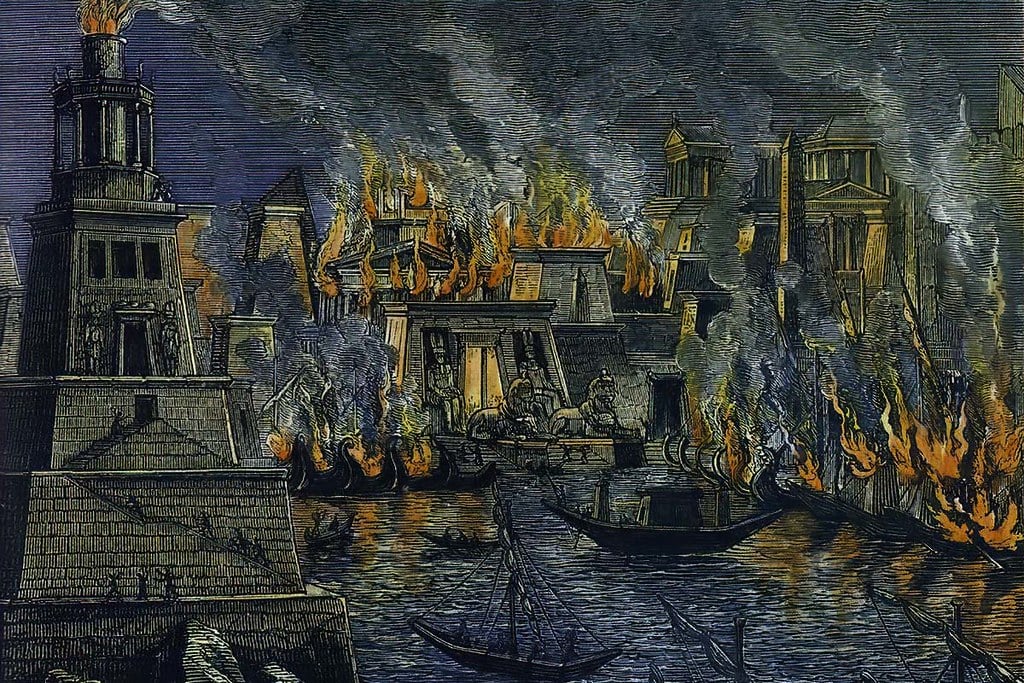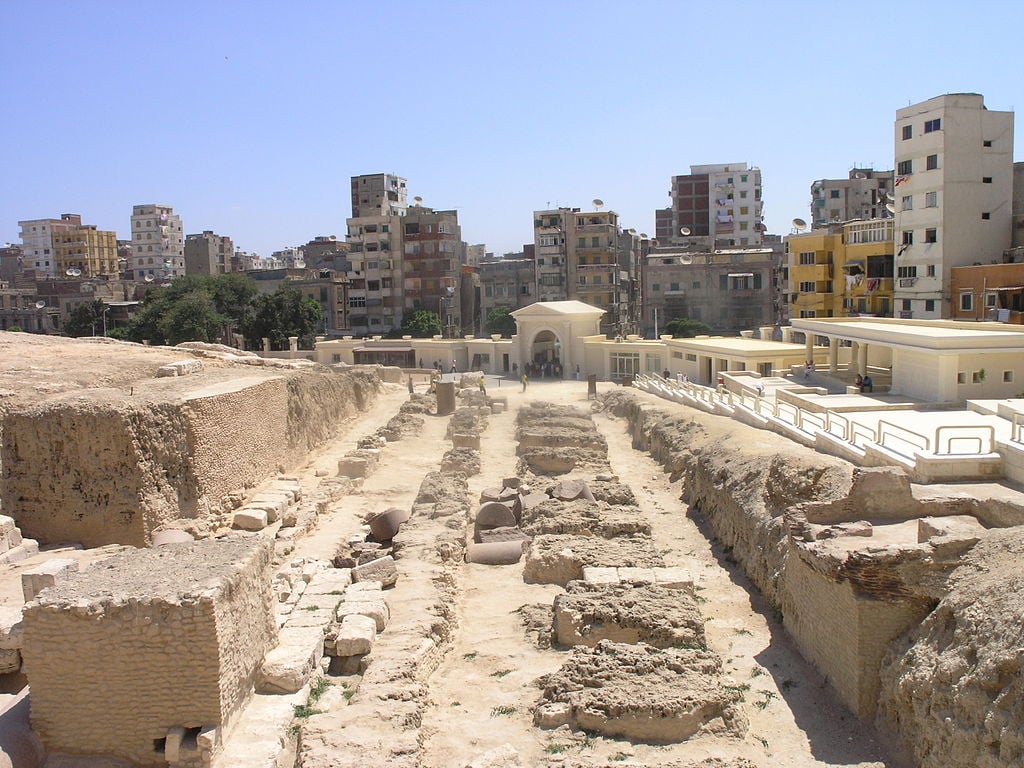
The ancient Library of Alexandria was one of the greatest human achievements in antiquity. It was a vast collection of knowledge from countless and varied sources and contained tens or possibly even hundreds of thousands of scrolls. For this reason, the destruction of the library has been a subject of keen interest by many lovers of knowledge. It is often regarded as a great tragedy. But who actually burned the Library of Alexandria?
What was the Library of Alexandria?
Firstly, let us establish an understanding of what exactly the Library of Alexandria really was. It was part of a large center of learning in Egypt in the city of Alexandria, called the Mouseion. It was built during the Ptolemaic period of Egypt. This was a time during which a Greek dynasty ruled over the country (Hellenistic Era).
The library may have been built during the reign of Ptolemy II Philadelphus in the mid-third century BCE. It quickly acquired many scrolls from all sorts of sources. The Ptolemaic kings of Egypt supported it directly, due to the ancient Greek love of knowledge.
The Library of Alexandria grew to enormous proportions. At its height, it allegedly held anywhere between forty thousand to four hundred thousand scrolls. It was perhaps the greatest center of learning in the ancient world. Nonetheless, the library is no longer in existence but was famously burned. The question that remains is who was responsible for this.
Did Julius Caesar burn the Library of Alexandria?
Numerous dramatic events took place during the reign of Julius Caesar. Therefore, it should be no surprise that he had a hand in the burning of the Library of Alexandria. At one point during his war against Ptolemy XIII, the Greek forces surrounded him in Alexandria, both by land and by sea.
To escape, Caesar set fire to the enemy fleet in the harbor of the city. This strategy worked, but the fire also spread to the city itself, causing the Library of Alexandria to burn down too. According to Plutarch, a Greek historian from the first century CE:
Caesar was forced to repel the danger by using fire, which spread from the dockyards and destroyed the Great Library.
Thus, it appears straight-forward enough that Julius Caesar burned down the Library of Alexandria. This occurred in 48 BCE.
ouuu this lead me to more research and this article was the only thing i could find (quickly) that mentioned what may have been lost, which also wasnt a whole lot? https://t.co/UQO8dGw0VE
— they who walk silently (@elevenpyres) October 2, 2023
Did this really destroy the Library of Alexandria?
However, things are not quite that simple. Some scholars believe that there is evidence the Library of Alexandria still existed even after Caesar allegedly unintentionally set it on fire. Strabo, in the later first century BCE, visited Alexandria. In his writings, he describes a visit to the Mouseion. According to some scholars, this is evidence that the library, which was part of the Mouseion, still existed.
However, other scholars note that Strabo never actually mentions the existence of the library in his day. In fact, his words apparently imply that it was no longer even a thing. This is the view of the Encyclopedia Britannica.
Other scholars try to refute this by pointing to the fact that Mark Antony allegedly gifted two hundred thousand scrolls to Cleopatra. This was after Caesar had burned the Library of Alexandria. The logic goes that this must mean that the library still actually existed.
Otherwise, where would Cleopatra house all those scrolls? In fact, some experts believe this gift was likely to replenish the library’s collection after many of the scrolls had been burned in 48 BCE.

The Serapeum, the ‘daughter library’
However, this argument ignores the fact that there was a ‘daughter library’ elsewhere in Alexandria. This was called the Serapeum. It was actually a temple, but it was also used as an overflow for the main Library of Alexandria. Therefore, when Mark Antony gifted so many scrolls (and bear in mind, the source for this is late and the number could easily have been exaggerated) to Cleopatra, they could have been placed in the Serapeum.
This also potentially explains away another argument used in favor of the Library of Alexandria still existing after Caesar’s time. A scholar named Didymus Chalcenterus lived in the late first century BCE in Alexandria. He was a very prolific writer, allegedly producing thousands of works. Some scholars argue that he must have had access to the library’s resources to be able to do so.
However, the existence of the Serapeum explains this satisfactorily. There is no need to conclude that the Library of Alexandria continued to exist after Caesar burned it. In fact, there does not appear to be any direct reference to the library after that event. Still, we cannot exclude the possibility that it continued in a much more reduced form.
Did the Christians burn the Library of Alexandria?
Some sources attribute the final demise of the Library of Alexandria to the Christians. This is based on the perspective that the Serapeum was simply an extension of the main library. Ancient sources describe a major attack on the Serapeum in the early Christian period.
In 380 CE, Emperor Theodosius made Christianity the official religion of the Roman Empire. In the year 391, he issued a decree to ban the worship of pagan gods in Alexandria. This included destroying all the pagan temples. Theophilus, the bishop of Alexandria, led a massive attack on the Serapeum. He and his followers completely destroyed it.
Some modern sources say the Serapeum no longer functioned as a library when this happened. However, the contemporary writer Aphthonius visited the Serapeum just before it was attacked. He wrote:
On the inner side of the colonnade were built rooms, some which served as bookstores and were open to those who devoted their life to the cause of learning. It was these study rooms that exalted the city to be the first in philosophy.
This appears to confirm that it still functioned as a library when this Christian attack occurred. If this is correct (and some scholars do dispute this), then the Christians put a final end to the Library of Alexandria when they burned the Serapeum.
Did Arab Muslims burned the Library of Alexandria?
However, there is also another tradition which is worth investigating. In the seventh century CE, Arab Muslims invaded and conquered Egypt. In the thirteenth century, some Arab sources claimed that they had burned the Library of Alexandria.
According to such sources, Caliph Umar ordered its destruction. He allegedly said:
If those books are in agreement with the Quran, we have no need of them; and if these are opposed to the Quran, destroy them.
However, the vast majority of scholars today do not buy into this story. There were almost six centuries between the Arab conquest of Egypt and this event being described. None of the earlier accounts of the Arab invasion mention anything about this. For these and other reasons, most scholars believe that the Arabs did not, in fact, burn the Library of Alexandria.
See all the latest news from Greece and the world at Greekreporter.com. Contact our newsroom to report an update or send your story, photos and videos. Follow GR on Google News and subscribe here to our daily email!



